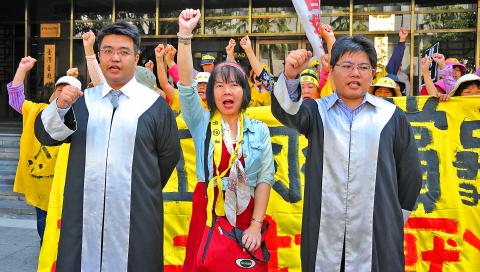Accompanied by several dozen former Hualon Corp workers, Hualon Self-Help Organization president Lee Tsui-ming (李翠明) came to the Taipei District Court for an inquiry session yesterday, over charges of violating the Assembly and Parade Act (集會遊行法) during a demonstration in January.
The workers retired from the bankrupt textiles manufacturer about a decade ago and are claiming an average of NT$1 million (US$33,000) each in unpaid pensions, after a court auction of Hualon’s assets in August provided them with less than NT$3,000 each in compensation.
Lee was summoned for leading an unauthorized demonstration in front of the Presidential Office Building on Jan. 27.

Photo: Liu Hsin-de, Taipei Times
She said the court did not notify her about any illegal behavior until last week, right before another surprise demonstration at the same location, which she said prompted speculation on the government’s judicial influence.
“We launched that [first] demonstration right before the Lunar New Year, because we really did not have any money left to celebrate the holidays,” Lee said. “We were forced to take to the streets for our pensions.”
Clad in signature yellow cloaks with the word “anger” written across their chests, the workers carried a large banner reading: “[The government is] slow as a turtle in providing compensation, while abusive in judicial prosecution.”
Human rights lawyers Chiu Hsien-chih (邱顯智) and Tseng Wei-kai (曾威凱), both volunteering their services for the Hualon case, condemned the court’s use of the Assembly and Parade Act, which they see as a violation of the workers’ rights.
“It always makes me sad to defend social activists, when the court should really be going after murderers or arsonists,” Chiu said.
Chiu also stated his support for the workers’ compensation: “If all the money from the Hualon auctions goes to the banks instead of the workers, I think Taiwanese society will never forgive our judicial system.”
With a pre-approval system that requires organizers to obtain permits from local authorities before rallies or protests, the Assembly and Parade Act has often been described as “a relic from the Martial Law era” by human rights advocates, with many campaigning for its abolition.

US climber Alex Honnold is to attempt to scale Taipei 101 without a rope and harness in a live Netflix special on Jan. 24, the streaming platform announced on Wednesday. Accounting for the time difference, the two-hour broadcast of Honnold’s climb, called Skyscraper Live, is to air on Jan. 23 in the US, Netflix said in a statement. Honnold, 40, was the first person ever to free solo climb the 900m El Capitan rock formation in Yosemite National Park — a feat that was recorded and later made into the 2018 documentary film Free Solo. Netflix previewed Skyscraper Live in October, after videos

Starting on Jan. 1, YouBike riders must have insurance to use the service, and a six-month trial of NT$5 coupons under certain conditions would be implemented to balance bike shortages, a joint statement from transportation departments across Taipei, New Taipei City and Taoyuan announced yesterday. The rental bike system operator said that coupons would be offered to riders to rent bikes from full stations, for riders who take out an electric-assisted bike from a full station, and for riders who return a bike to an empty station. All riders with YouBike accounts are automatically eligible for the program, and each membership account

NUMBERS IMBALANCE: More than 4 million Taiwanese have visited China this year, while only about half a million Chinese have visited here Beijing has yet to respond to Taiwan’s requests for negotiation over matters related to the recovery of cross-strait tourism, the Tourism Administration said yesterday. Taiwan’s tourism authority issued the statement after Chinese-language daily the China Times reported yesterday that the government’s policy of banning group tours to China does not stop Taiwanese from visiting the country. As of October, more than 4.2 million had traveled to China this year, exceeding last year. Beijing estimated the number of Taiwanese tourists in China could reach 4.5 million this year. By contrast, only 500,000 Chinese tourists are expected in Taiwan, the report said. The report

Temperatures are forecast to drop steadily as a continental cold air mass moves across Taiwan, with some areas also likely to see heavy rainfall, the Central Weather Administration (CWA) said. From today through early tomorrow, a cold air mass would keep temperatures low across central and northern Taiwan, and the eastern half of Taiwan proper, with isolated brief showers forecast along Keelung’s north coast, Taipei and New Taipei City’s mountainous areas and eastern Taiwan, it said. Lows of 11°C to 15°C are forecast in central and northern Taiwan, Yilan County, and the outlying Kinmen and Lienchiang (Matsu) counties, and 14°C to 17°C